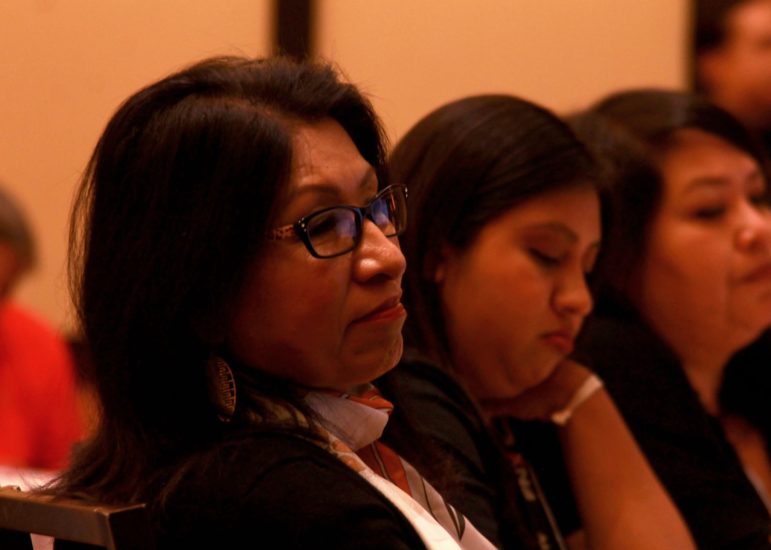With new strategic plan, Native Public Media seeks collective ‘vision for tomorrow’
Native Public Media is beginning a new process of strategic planning to shape its identity and policies as it continues to serve tribal stations over the next four years.
Founded in 2004, NPM provides support for 60 radio stations and five television stations serving American Indian tribes and Alaska Native villages. It also works as an advocate for indigenous people in national and international communication policy.
This year’s strategic plan, which will be created this summer, will focus on key questions of NPM’s identity, values and ability to survive new and continuing challenges, according to CEO Loris Taylor.
Taylor said she envisions NPM as a “strong, healthy and robust backbone for Indian Country that really contributes to healthy, independent, resilient Native American communities.” The 2019 plan will define what that looks like and how NPM will get there, Taylor said.
Station leaders, NPM’s staff and board, and its advisory committee of seven station representatives will participate in the planning process, according to Taylor.
NPM hosted a preliminary conversation about its next phase during its annual Native Broadcasters Summit in Chandler, Ariz., April 24 and 25. Discussion highlighted issues that may be incorporated into the strategic plan, according to Taylor, including the need for greater engagement with first responders for emergency communications and ways stations can expand their technological capabilities.
When NPM was new, “it was good to be inward-looking,” Taylor said. “But now, I think we need to balance that out with some outward perspective as well as a window of opportunity to enhance programs we already have.”
Compliance and content
NPM’s initiative to help stations comply with requirements for Community Service Grants from CPB, a major focus of the 2014 strategic plan, will continue to be a focus in the 2019 plan. NPM helps the 36 tribal stations that receive CSGs understand and meet the requirements.
Meeting the requirements for CSGs, such as the requirement for stations to match CPB funds, can be difficult for tribal stations because they “don’t have the same access to donors and dollars like urban or even rural stations have,” said Richard Davis, NPM board secretary and a host at KNAU in Flagstaff, Ariz.
Based on feedback from station members at the annual summit, NPM will look at teaching financial literacy and providing additional trainings and resources to expand the compliance program in the new plan, Taylor said.

Funding from the U.S. federal government also affects stations supported by licensees. During the longest government shutdown from December 2018 to January 2019, a “ripple effect” occurred across Indian Country as tribes started to tighten their budgets and channel funds to other services, Taylor said.
The 2019 plan will create more trainings and resources to prepare stations for recovering from changes in funding, according to Taylor.
When stations are focused on funding, they have less time to spend on programming, Taylor said.
The new strategic plan will also focus on sharing programming among stations. NPM’s previous plan mentioned content-sharing but prioritized strengthening the network of tribal stations through sharing resources and promoting accountability among stations for reaching their goals. Those connections didn’t exist before NPM was created, according to Taylor.
“We’ve been about infrastructure for a very long time — we’ve been building the ‘highway,’” Taylor said. But now, she says, stations say, “Well, you build the highway. What about putting the cars on the highway?”
Stations can have trouble sharing content because programming is often hyperlocal in focus, according to Davis, who is also a member of NPM’s station advisory committee. Stations try to tailor programming to the unique culture and needs of the different tribes they serve. That can make programming about revitalizing tribal languages, for example, difficult to share. But NPM hopes to share a structure for such a show that could be applied across stations, said Davis.
‘Vision for tomorrow’
The strategic plan will also have a more global focus as NPM looks to advocate for indigenous people in international communications policies by working with the International Corporation for Assigned Names and Numbers, which manages the internet’s domain names and IP addresses. As ICANN’s only member representing Native Americans, NPM aims to give indigenous people a voice in the discussion of bandwidth and internet rights, Taylor said.
Since joining ICANN, NPM has established an indigenous ambassador program that includes two representatives from indigenous communities in ICANN’s international meetings.
Participating in international, as well as domestic, policymaking is important to NPM constituents, Taylor said. “There’s been a conversation in NPM that because tribes are sovereign nations, we’re not just tied to domestic policy, but also international policy,” Taylor said. “If the internet is a global platform, where are indigenous people in terms of this development, and how can we work together?”
Policies affecting one indigenous group could also affect NPM members, Taylor said. Broadband allocation is one such issue.
With broadband resources quickly becoming scarce, NPM needs to be at the forefront of conversations about global internet policies, said Hector Youtsey, GM of KPYT-LP in Tucson, Ariz., and a member of NPM’s station advisory committee.
“There’s nothing left for native media, and we’ve been ignored for so long,” he said. “Native Public Media is a good way to make sure Indian Country gets what’s coming to them.”
NPM will work on prioritizing these and other issues at a strategic planning meeting in July. Taylor said she believes the most important issue the plan will address is reevaluating NPM’s mission statement.
“At the end of the day, we need to agree what we want NPM to be,” Taylor said. “We need a vision for tomorrow. It has to be a collective vision.”





